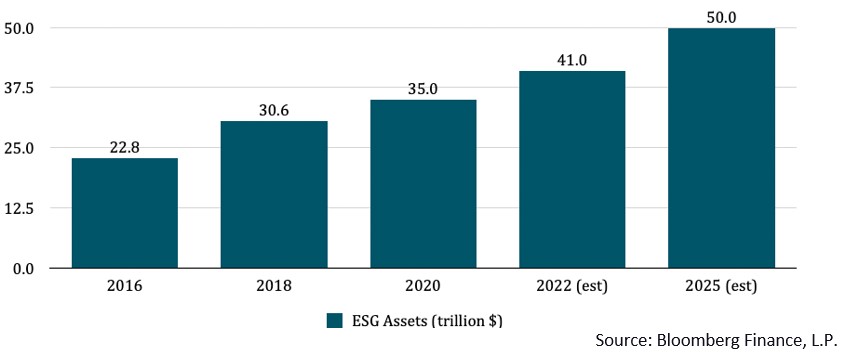In ESG Investing, Money Changes Everything
ESG investors put their money where their mouths (and hearts and minds) are by investing in companies with better management of environmental, social and corporate governance factors.


Cyndi Lauper was not commenting on ESG investing when she sang “Money Changes Everything” in 1984. But she could have been. The entire premise behind ESG investing is to use the power of money to create positive change.
What is ESG? ESG encompasses broad areas that companies routinely impact, for better or worse. Businesses inevitably affect the environment (E) and can develop policies that minimize or neutralize the negative effects or produce positive effects in areas such as carbon emissions, water usage, green energy and pollution, to name a few.
Companies also impact the social (S) element, or the relationships it has with people and institutions in their community — that influence is demonstrated through hiring and labor practices, diversity and inclusion policies, workplace safety and philanthropy.

Sign up for Kiplinger’s Free E-Newsletters
Profit and prosper with the best of expert advice on investing, taxes, retirement, personal finance and more - straight to your e-mail.
Profit and prosper with the best of expert advice - straight to your e-mail.
Finally, firms decide on governance (G) — the internal system of practices, procedures and controls for decision-making, governing itself and complying with the law. Governance includes matters such as board diversity, executive pay, business ethics, competitive fairness and financial processes.
ESG Investing Is Growing in Popularity
ESG investing has become an increasingly popular trend, but it’s not just a fad, as ESG assets have been steadily growing for decades now. Globally, ESG investors are increasingly putting their money where their mouths (and hearts and minds) are to the tune of a projected $50 trillion by 2025, up from $35 trillion in 2020. ESG assets represent a third of total global assets under management.

If the money is there, the next question is, is it creating positive change? The answer can be found by looking at examples of how industries and companies have created change with ESG in mind.
- Traditionally, mergers and acquisitions involve a firm making decisions primarily based on whether the target business would increase earnings. Now, firms are increasingly considering ESG priorities when deciding with whom to partner or acquire. For example, companies in the energy sector consider how the deal will benefit them with regard to clean energy, decarbonization targets and supply chains with sustainable sourcing practices.
- J.B. Hunt Transport Services, Inc. sets the bar in making the environment a priority. Its goal is to reduce carbon emission intensity by 32% by 2034 through alternative-powered equipment, more biogenic fuels and better fuel economy. The company also makes use of intermodal shipping, which is more efficient and involves fewer carbon emissions than over-the-road shipping.
- Green investing has incentivized companies like Graphic Packaging Holding Co., a producer of packaging material for food, beverage and consumer-products companies, to shift from producing plastic products to more sustainable paper goods. Changes like this bring us one step closer to a world free of foam cups, plastic takeout containers and six-pack rings.
- A growing number of corporations are issuing impact bonds to meet their ESG goals. In 2022, the agricultural company Archer Daniels Midland (ADM) issued $750 million of bonds with the proceeds going to environmental and social programs. According to the company's website, ADM’s sustainability goals include reducing greenhouse gas emissions by 25%, energy intensity by 15% and water intensity by 10% and achieving a 90% landfill diversion rate, all by 2035.
Just as ESG assets are on the rise, opportunities to invest are likewise growing. The most common way to invest in ESG and be automatically diversified is to choose from the hundreds of ESG mutual funds and ETFs available.
Personalized Indexing Gives Investors More Flexibility
An exciting development, though, is the personalized indexing (PI) option that has more recently emerged.
PI allows an investor to choose exactly which companies will be in their ESG fund, akin to the best Las Vegas casino buffet in investing. An investor could fill a plate with a scoop of wind energy, a dollop of social justice and a sprinkling of gender diversity while actively avoiding any helpings of animal testing or slices of unethical behavior.
This custom-tailored approach ensures the fund will precisely align with the investor’s values, rather than relying on a fund manager’s judgment, as well as provide enhanced opportunities to improve the tax efficiency of the investor’s portfolio.
So Many Choices Can Be Overwhelming
It's always nice to have a choice, and clearly the choices are plentiful when it comes ESG investing. Sometimes, however, those choices can also make investing seem somewhat overwhelming. The most surefire way to make sure your portfolio not only aligns with your values but also meets your overall investment goals is to work with a financial adviser well-versed in ESG.
ESG investors can feel good about intentionally and thoughtfully using their dollars to make a difference. ESG investing provides the opportunity to receive a return on an investment while prioritizing the environment, people and ethics at the same time.
Without ESG, would some companies independently create change on their own and focus on environmental, social and governance issues to make positive strides in those areas? Of course. Some companies would, but others would not.
The pressure and financial incentive to make that progress is important in encouraging good behavior across the board. The goal for many ESG investors is just that — to encourage positive change in our world by investing in funds and companies that prioritize those changes. Money talks, and beyond that, it has the potential to change everything.
Get Kiplinger Today newsletter — free
Profit and prosper with the best of Kiplinger's advice on investing, taxes, retirement, personal finance and much more. Delivered daily. Enter your email in the box and click Sign Me Up.

Stacy is a nationally recognized financial expert and the President and CEO of Francis Financial Inc., which she founded over 20 years ago. She is a Certified Financial Planner® (CFP®), Certified Divorce Financial Analyst® (CDFA®), as well as a Certified Estate and Trust Specialist (CES™), who provides advice to women going through transitions, such as divorce, widowhood and sudden wealth. She is also the founder of Savvy Ladies™, a nonprofit that has provided free personal finance education and resources to over 25,000 women.
-
 6 Stunning Waterfront Homes for Sale Around the US
6 Stunning Waterfront Homes for Sale Around the USFrom private peninsulas to lakes, bayous and beyond, Kiplinger's "Listed" series brings you another selection of dream homes for sale on the waterfront.
By Charlotte Gorbold Published
-
 Six Reasons to Disinherit Someone and How to Do It
Six Reasons to Disinherit Someone and How to Do ItWhether you're navigating a second marriage, dealing with an estranged relative or leaving your assets to charity, there are reasons to disinherit someone. Here's how.
By Donna LeValley Published
-
 Should You Still Wait Until 70 to Claim Social Security?
Should You Still Wait Until 70 to Claim Social Security?Delaying Social Security until age 70 will increase your benefits. But with shortages ahead, and talk of cuts, is there a case for claiming sooner?
By Evan T. Beach, CFP®, AWMA® Published
-
 Retirement Planning for Couples: How to Plan to Be So Happy Together
Retirement Planning for Couples: How to Plan to Be So Happy TogetherPlanning for retirement as a couple is a team sport that takes open communication, thoughtful planning and a solid financial strategy.
By Andrew Rosen, CFP®, CEP Published
-
 Market Turmoil: What History Tells Us About Current Volatility
Market Turmoil: What History Tells Us About Current VolatilityThis up-and-down uncertainty is nerve-racking, but a look back at previous downturns shows that the markets are resilient. Here's how to ride out the turmoil.
By Michael Aloi, CFP® Published
-
 Home Insurance: How to Cut Costs Without Losing Coverage
Home Insurance: How to Cut Costs Without Losing CoverageNatural disasters are causing home insurance premiums to soar, but don't risk dropping your coverage completely when there are ways to keep costs down.
By Jared Elson, Investment Adviser Published
-
 Markets Roller Coaster: Resist the Urge to Make Big Changes
Markets Roller Coaster: Resist the Urge to Make Big ChangesYou could do more harm than good if you react emotionally to volatility. Instead, consider tax-loss harvesting, Roth conversions and how to plan for next time.
By Frank J. Legan Published
-
 Why Homeowners Insurance Has Gotten So Very Expensive
Why Homeowners Insurance Has Gotten So Very ExpensiveThe home insurance industry is seeing more frequent and bigger claims because of weather, wildfires and other natural disasters.
By Karl Susman, CPCU, LUTCF, CIC, CSFP, CFS, CPIA, AAI-M, PLCS Published
-
 Going Through Probate? How to Find the Right Attorney
Going Through Probate? How to Find the Right AttorneyJust having the skills and experience to do the job isn't enough. The probate attorney you hire needs to have the right temperament for your particular case.
By John R. Silva, Esq. Published
-
 Widow's Penalty: Three Ways to Protect Your Finances
Widow's Penalty: Three Ways to Protect Your FinancesHigher Medicare premiums, smaller Social Security payments, bigger tax bills … Financial changes can hit hard when a spouse dies. How to counter the blow.
By Ashley Terrell, IAR Published